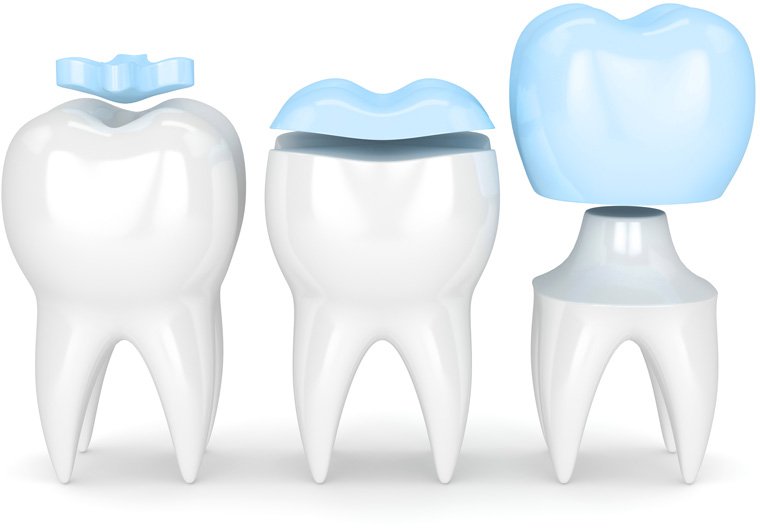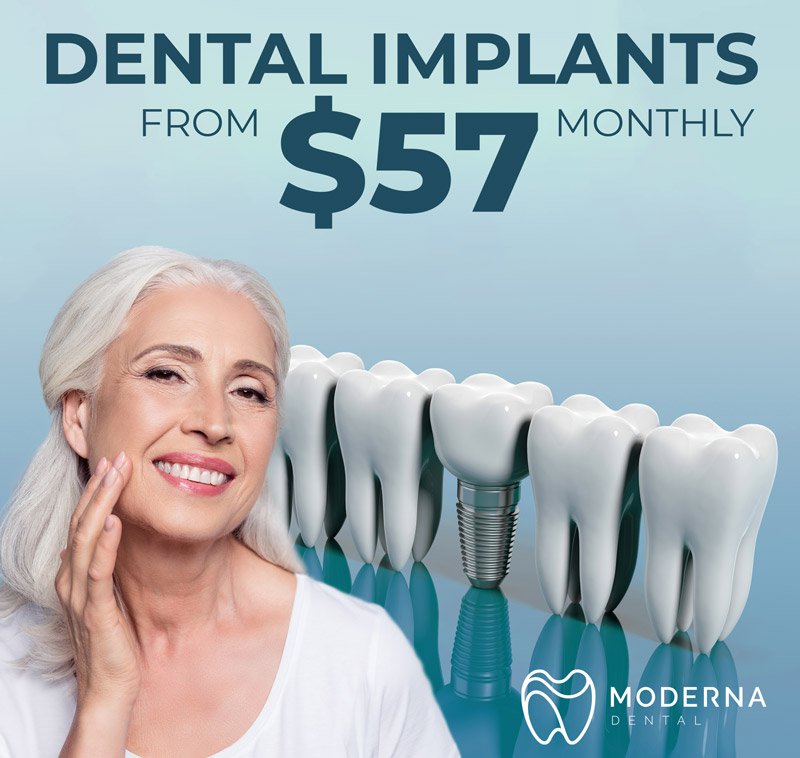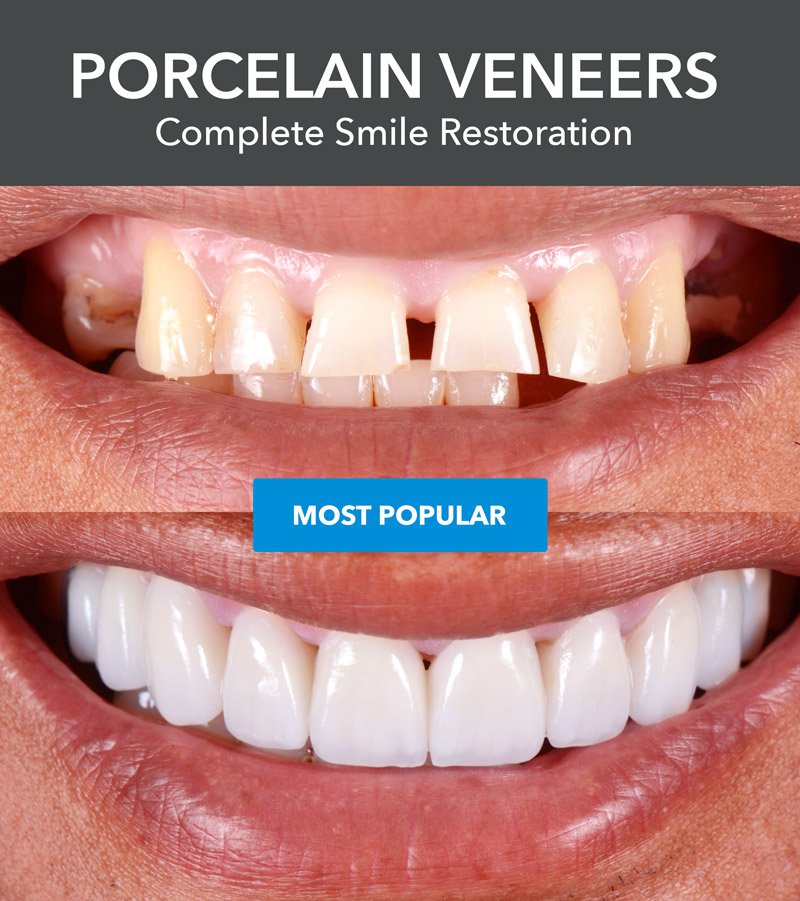Porcelain Crowns
Bring back that beautiful smile! Moderna Dental places dental crowns in Miami. We offer Empress®, eMax, monolithic, and porcelain dental crowns.

 Dental Crowns in Miami: Restore Your Smile
Dental Crowns in Miami: Restore Your Smile
Dental crowns, or “caps,” are used to restore the function and appearance of a tooth that has become fractured, chipped, decayed, or undergone a root canal procedure. In years past, only gold and porcelain veneers were available. Nowadays, dental crowns come in a vast assortment of durable, lifelike materials. These include options such as lithium disilicate, ceramic glass, and yttria-stabilized zirconia.
To bring dental crowns to Miami, Moderna Dental offers crown placements as part of our comprehensive Moderna Smile Makeover. Contact us today to schedule a dental crown consultation.
What are Dental Crowns?
Dental crowns, or “caps,” fall under two categories of dentistry: dental restorations and cosmetic dentistry. The primary purpose of a dental crown is to strengthen and protect a tooth compromised by tooth decay, a fracture, or has undergone root canal therapy, but dental crowns are also used for cosmetic purposes.
At Moderna Dental, we have a master ceramist on site to make the process of having a dental crown placed as quick and convenient as possible. (Plus, you'll love the results!)
Dental crowns are available in a range of materials, including ceramic, eMax, zirconia, Empress®, and monolithic zirconia. We would be happy to recommend a type that will work best for your esthetic and oral health goals.
Why are Dental Crowns Used?
Dental crowns are used to treat a range of conditions that threaten the health, stability, and appearance of a tooth. Your dentist may recommend a dental crown under one of the following scenarios:
- You have a cavity that cannot be treated with only a filling
- You have a tooth that is worn down and missing enamel
- You have an advanced stage of tooth decay and the tooth is weakened
- You’ve undergone root canal therapy and need a crown to stabilize the tooth
- You have a tooth that is fractured or cracked
- You wish to cosmetically enhance a tooth that is diminishing your smile
What’s a Dental Crown Procedure Like?
Prior to starting the process, the dentist will likely order X-rays or a CT scan. The dentist uses information from these scans to gain a better understanding of your general oral health and determine if there are any issues below the surface that could complicate your dental crown procedure.
Preparing the tooth. Before a crown can be placed, the tooth will need to be prepared. The process involves having a portion of the tooth enamel shaved in a process known as enameloplasty or odontoplasty. The purpose of this is to slightly reduce the thickness of the tooth so a crown can be placed on top without interfering with neighboring teeth.
Impressions. Once the tooth has been prepared, the dental staff creates an impression of the tooth and the surrounding teeth. This impression is sent to a dental fabrication lab that will then craft the crown in the desired material. Depending on the type of process used, you may leave your first appointment with a temporary crown.
Fitting and placement. If you have a temporary crown, the dentist will schedule a follow-up appointment to swap the temporary for a permanent crown. Before cementing the permanent dental crown in place, the dentist will place it on the prepared tooth to check its fit and appearance. This step is important; a poor-fitting dental crown can significantly reduce its lifespan. If the dentist finds the crown to be free of flaws and you approve its fit and appearance, the dentist will then cement the crown into place.
What is the Cost of a Dental Crown?
Like other types of dental restorations, it can be difficult to estimate the cost of dental crowns. For one, the cost can vary based on the materials selected. Secondly, practitioners sometimes charge a premium for their expertise. As a ballpark figure, you can expect to pay somewhere in the range of $1,100 to $3,700 for a dental crown.
How Long Do Dental Crowns Last?
Most information you will find on the web will quote a 5 to 15-year lifespan for dental crowns. But it should be noted that lower quality dental crowns are responsible for this low averages. When quality materials are used by an experienced practitioner and the patient takes the necessary precautions to extend the life of the crown, dental crowns can last upwards of 30 years.
Dental Crown Aftercare
Following your appointment to have your dental crown placed, you will receive information and advice on how to maintain your dental restoration. Some sensitivity should be expected the days and weeks following your crown placement. This is due to some natural tooth material (enamel, dentin, etc.) being removed, which means the nerves are now closer to the surface of the tooth. In time, this increased sensitivity will subside.
Caring for your dental crown. It’s important to note that while dental crowns are not subject to cavities in the traditional sense, the gums around the crown do require proper oral health care. Keeping gums healthy is also cosmetically important as a receding gum line can reveal the crown margin, which will require crown lengthening later on.
Be sure to brush twice a day and floss using traditional floss or interdental cleaners. Depending on the type of restoration, you may want to avoid pulling floss away from the gums when flossing between teeth as this could potentially loosen or dislodge the dental crown. Instead, draw the floss through the teeth when you are moving onto the other side of the tooth.
Things to avoid. While some dental crowns are more resilient than others, there is no such thing as a fracture-proof dental crown. Your dentist may caution against the following:
- Hard foods (ice, hard candies, granola, etc.)
- Sticky foods (gum, taffy, caramel, etc.)
- Tough foods (steak, French bread, biscotti, etc.)
If you experience bruxism (teeth grinding), this will factor into the type of dental crown material recommended to you. Depending on the type of material, many dentists will also caution against excessively hot or cold foods and drinks.
What are Dental Crowns Made Of?
If we asked you when the first dental crowns were invented, you would most likely be a few thousand years off. Archaeologists in the Philippines have uncovered 4,000-year-old skeletal remains that had dental crowns made of gold. Fortunately, dental crowns have made leaps and bounds over the past 50 years, yielding materials that are more durable and realistic than ever before.
Dental crowns are fabricated in a variety of materials. The most popular options include:
- eMax (lithium disilicate)
- Empress® (ceramic glass)
- Zirconia (zirconium dioxide)
- Monolithic zirconia (yttria-stabilized zirconia)
- Porcelain
The dentist will most likely recommend a type of crown that fits your esthetic and oral health goals. The location of where the crown will be placed is also an important consideration. A crown placed on a molar requires more durability than, say, one being placed on an incisor.
How Much Tooth Enamel is Removed to Place a Crown?
Different types of crown materials require different amounts of tooth enamel to be removed. Each crown type requires a certain amount of enamel to be removed. This is done to ensure the placement is strong and stable. On average, 65-75% of the tooth enamel is removed. This sounds like a lot, but it’s important to remember that tooth enamel, on average, only 2.5 mm thick.
Is it Painful to Have a Dental Crown Placed?
Having a dental crown placed comes with about as much discomfort as having a dental filling performed. To help with any pain or discomfort, the dentist may apply a local anesthetic and/or offer conscious sedation.
How Many Visits are Needed for Crown Placement?
While there are same-day, single-appointment crown options, most crowns require two or three appointments. During the first appointment, the dentist prepares a tooth and takes impressions. On the follow-up visit (typically several weeks later), the permanent crown is then placed.
How Do Same-Day Dental Crowns Work?
Dentists are able to offer same-day crowns by using the latest technologies to replace two time-consuming steps: taking impressions and fabricating the crown. Instead of taking impressions (in the traditional sense) and then sending these to a lab to fabricate the crown, 3D-imaging technology is used to create a highly accurate digital scan of the teeth. These 3D scans are then sent to a computer-aided manufacturing (CAM) device that will then create a crown in the patient's chosen material. Using this method, a dentist can create and place a crown all in one visit.


